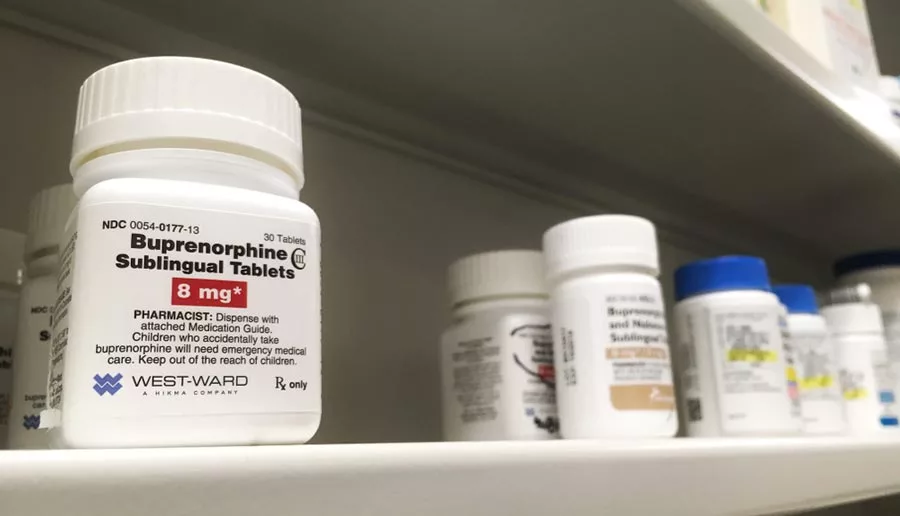Using Medication to Overcome Withdrawals and Cravings
The pain of addiction can be excruciating. When individuals fall into substance abuse disorder, the marks that are left on them can last a lifetime. Medication-assisted treatment can often make a difference.
A great majority of the time, these marks aren’t physical in nature. The mental portion of substance abuse can take the greatest toll on anyone who has a history of battling this condition.
Attempting to complete recovery for many people can be extremely difficult. After years of abuse, many substances rewire the way the users’ brain interacts with certain chemicals and neurotransmitters.
This presents significant mental hurdles, but in some cases, physical challenges loom as well. An example of this is the physical withdrawals associated with opioid detox.
Luckily, advances in medicine and treatment currently grant many users the option to participate in medication-assisted treatment (MAT). This process includes using certain prescription medications to ease the discomfort of withdrawal and provide relief during the post-acute withdrawal phase.
Keep reading to learn how Exclusive Hawaii Rehab uses the latest medications and evidence based practices to help ensure our clients have the best foundation for lasting recovery!
What Is Medication-Assisted Treatment or MAT?


Medication-assisted treatment is an approved form of therapy used to battle substance use disorder. This treatment is used during multiple stages of the recovery process.
Typically, the opioid detox process comes to mind when people think of medication-assisted treatment. While this is one form of MAT, it certainly isn’t the only form.
Medication-assisted treatment encompasses any type of pharmaceutical assistance used during the recovery process. The goal of MAT is to either aid in the detox process or prevent relapse by eliminating the cravings associated with the post-acute withdrawal phase.
Several forms of therapy fall under the category of medication-assisted treatment. However, only three are officially approved by the FDA.
Experience True Healing
Our deeply-caring staff and the surrounding natural beauty offer an unparalleled healing experience.
What are the Main Types of Medication-Assisted Therapies?
Currently, three forms of medication-assisted therapy exist that are FDA-approved. These methods include:
Methadone Treatment
Methadone maintenance programs exist for individuals who suffer from opiate abuse disorder. These treatment programs allow clients to receive a daily regimen of methadone to keep symptoms of withdrawal at bay and manage cravings.
Once a stable dose is achieved, clients remain at that level until they decide to taper down. There is no set window of time for clients to remain on methadone treatment.
During their participation, clients are required to meet with counselors on a regular basis. Additionally, group recovery meetings are also available, although typically, these are usually voluntary.
Overall, methadone maintenance programs have been considered successful.
Buprenorphine Maintenance


Buprenorphine is a substance designed to help individuals avoid the uncomfortable symptoms of detox and avoid cravings in the later stages of recovery. This mediation is the active ingredient in Suboxone and Subutex and acts in a way that forces the brain to recognize it as an opioid.
Many methadone clinics have adopted Suboxone programs similar to methadone, where clients must show up daily to receive their dose. However, up until the last few years, buprenorphine maintenance was only available through doctors who were licensed to treat clients with it.
This can be used as a short or long-term treatment choice. Some individuals choose to go through what’s called a six to eight-week buprenorphine taper. During this period, clients ween from opioids as buprenorphine is introduced. They hit a peak dose, are allowed to stabilize, and then slowly decrease the dose.
Otherwise, clients receive a monthly prescription for their medication and normally see the doctor once or every other month. They’re also required to receive mental health treatment while prescribed Suboxone or Subutex simultaneously.
Overall, buprenorphine has also been considered a successful form of treatment.
Naltrexone
Naltrexone is slightly different from the two previous types of therapy mentioned. This drug is given in the form of a monthly injection, and clients must wait for a period of eight to 10 days after their last opioid use to receive this injection.
Because of these requirements, Naltrexone is only effective for the treatment of post-acute withdrawal symptoms and cravings. This medication is typically given to clients after completing detox and entering inpatient or outpatient treatment programs.
Additionally, this medication is given at any doctor’s office where buprenorphine is available (most of the time). It’s important to note that individuals who don’t wait the recommended eight to 10 days to receive Naltrexone have a high risk of developing precipitated withdrawals.
Clients have responded positively to Naltrexone treatment as well.
Additional Forms
Additional forms of medication-assisted treatment exist; however, there is no permanent regimen or medically-recommended process because the FDA does not back them. These forms include:
Alcohol Methods
Alcohol doesn’t have an FDA-approved medication for alcohol abuse treatment. However, many physicians will use certain prescriptions on an off-label basis to treat clients. Acamprosate, disulfiram, and Naltrexone are commonly prescribed to clients suffering from alcohol abuse disorder.
Methamphetamine
Currently, no specific medication is even given off-label for methamphetamine use disorder. However, certain medicines like benzos and anti-depressants have shown the potential to provide clients with relief during detox. Presently, scientists are working on options for recovering methamphetamine users.
Experience True Healing
Our deeply-caring staff and the surrounding natural beauty offer an unparalleled healing experience.
Is MAT Only for Opioids?
While the FDA has only approved three specific medications that are approved for medication-assisted treatment (all for opioids), other forms can be beneficial for other classes of drugs.
Physicians use multiple types of medications to help clients daily in their battle for recovery. Just because one certain type isn’t FDA-approved doesn’t mean it isn’t effective. It just means there isn’t enough scientific testing to prove its benefits on a wider scale.
This type of testing and research can total millions and take huge amounts of resources. However, professionals from the medical and science industries are working on new medication-assisted treatments and testing old ones.
The Benefits of Medication-Assisted Therapies


Medication-assisted therapies have proven to give clients significant benefits. When compared to cold-turkey detox methods or opioid users who don’t participate in some type of MAT treatment, chances of long-term recovery are much higher with MAT.
The following list is some of the primary benefits of medication-assisted treatment:
- Individuals are given the opportunity to return to a normal style of life without worrying about chasing a substance every day. It’s difficult to manage a normal life when the main priority is coming up with the money to purchase a substance that allows you to function without pain.
- Instead of going through the physical detox, then dealing with the mental portion, the medication-assisted treatment allows clients to do the opposite. It can be difficult to maintain recovery during the days and weeks after physical detox is complete. Individuals still have the mindset of capitalizing on the opportunity to use without being sick afterward. It’s the common “I’ll just do it once, but that’s it” way of thinking. However, when clients can have a significant amount of time to think with a sober mind, approaching the physical detox portion months later ends up producing much better results. The clean time the client has put in and worked for holds more weight when it comes to making the decision to relapse. A large majority of clients are reluctant to throw all of that hard-earned time out the window.
Alternatively, with all benefits normally comes certain drawbacks as well.
The Potential Drawbacks of MAT
There are certain drawbacks that come with medication-assisted treatment. Some of the following situations could be considered pitfalls of these programs:
- Individuals could use MAT as a way to continue using without having to worry about the consequences of withdrawal. Some clients will continue to abuse drugs and attempt to remain on medication-assisted treatment during times when drugs can’t be obtained.
- One concern is a client possibly remaining in a program for too long, using it as a crutch.
However, there are certain methods used to counteract these situations. Most clients are given random drug tests, which helps to avoid the first drawback.
The second drawback is improved upon through the use of counseling taking place in combination with medication-assisted treatment. Therapists are able to guide clients during their journey, offering them tips on when it may be time to start decreasing their medication.
Finding Medication-Assisted Treatment Near Me
“Finding medication-assisted treatment near me” is heavily searched for on a daily basis. This proves the number of individuals who are looking for recovery.
Multiple sources exist for obtaining medication-assisted treatment. Consider the following options:
- Methadone is the most strict when it comes to receiving treatment. Only state and federally-licensed facilities with the sole purpose of treating individuals for opioid abuse disorder may dispense methadone. The only exception to this is a doctor’s office prescribing methadone for pain, but it can’t be prescribed for opioid abuse treatment. Methadone clinics and inpatient rehabs are the only two sources of methadone maintenance.
- Buprenorphine is available at certain methadone clinics, most inpatient rehabs, and many physician’s offices. The clinic doesn’t have to exist for the sole purpose of buprenorphine treatment. As long as the physician is certified to prescribe buprenorphine, it’s possible to receive it from your primary care doctor.
- Naltrexone is available in the same places and is actually much easier to receive, as it’s only administered on a once-per-month basis by a registered nurse or physician.
Traveling for Medication Assistance as Part of Rehab


Many individuals will find that their area doesn’t provide a rehab that includes the elements they need for recovery. Certain clients may require a facility that specializes in dual-diagnosis or other forms of treatment, and a local option isn’t available.
Traveling for medication assistance as part of rehab is mandatory during these situations. This could have several benefits, however, when compared to remaining close to home for treatment.
- Traveling for rehab provides a new environment and a fresh outlook on life. Many of the painful memories and temptations associated with substance abuse may take a backseat while clients focus on recovery and getting clean.
- Privacy is another concern. Many individuals don’t want it known publicly when they enter treatment. Going somewhere out of state is an option when it comes to discretion.
- Many individuals find it easy to exit recovery if they’re close to home for the sole purpose of scoring drugs. Maybe the discomfort of detox is too much for them to handle, or they’re simply going through a craving, and access to their drug of choice is too easy. Going away for rehab can mitigate these risks and others, leading to a much higher chance of successfully completing a rehab program.
If you end up traveling out of state for rehab and receive medication-assisted treatment, it’s important to plan accordingly for your graduation. Are you planning on continuing medication-assisted treatment after rehab?
Many clients plan to continue participating in methadone maintenance or buprenorphine treatment even after completing rehab. This is especially true in cases of clients who suffer from a long history of substance abuse.
Clients may also choose to receive Naloxone injections after completing rehab to lower the sting of cravings. You must ensure that sources for these medications exist near home when you’re set to return.
For buprenorphine and naloxone, a distance of an hour or two shouldn’t be a hurdle, considering you only need to see the physician on a monthly basis.
However, keep in mind that methadone treatment (and buprenorphine within a methadone clinic) require you to show up daily to receive your medication. These clinics also operate early hours, with some opening their doors at 4 am and closing at 9 am.
Any drive over an hour to an hour and a half must be considered unrealistic, and you may want to consider alternative means before you leave rehab.
Experience True Healing
Our deeply-caring staff and the surrounding natural beauty offer an unparalleled healing experience.
Is Lasting Recovery Possible with Medication-Assisted Treatment?
At Exclusive Hawaii Rehab, we’ve helped hundreds, even thousands, of clients experience long-term recovery. Some of them participated in medication-assisted treatment, were able to see recovery through all the way, and still remain in recovery.
Our expert staff is well-versed in helping clients navigate medication-assisted treatment and helping them prepare for life after rehab. We’d love to help you complete your success story – contact one of our Intake Coordination team now to find out more about our treatment programs!